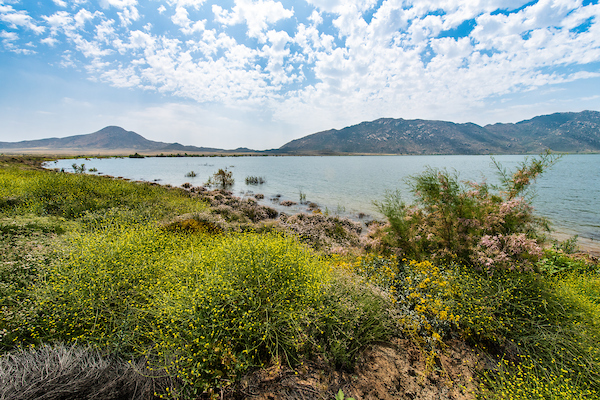Lake Perris in Riverside County. DWR/2019
SACRAMENTO, Calif. – The Department of Water Resources (DWR) today removed a danger advisory that had been in effect since May 17 at Moreno Beach at Lake Perris in Riverside County. Swimming is now permitted at the beach, however, DWR urges all recreational users to exercise caution and avoid direct contact with blue-green algae.
DWR lowered the advisory level at Moreno Beach to caution after detecting a reduced amount of microcystins for a second consecutive week. All beaches at Lake Perris are open with a lakewide caution advisory.
Advisories are based on the potential health risks from algae. Exposure to toxic blue-green algae, also known as cyanobacteria, can cause eye irritation, allergic skin rash, mouth ulcers, vomiting, diarrhea, and cold- and flu-like symptoms. Pets can be especially susceptible because they tend to drink while in the water and lick their fur afterwards.
Bloom conditions can change rapidly, and wind and waves may move or concentrate the bloom into different regions of the reservoir. The algal bloom can accumulate into mats, scum, or form foam at the surface and along the shoreline, and range in color from blue, green, white, or brown.
State guidelines on cyanobacteria and harmful algal blooms recommend the following precautions be taken in waters impacted by blue-green algae:
- Do not let pets and livestock drink the water, swim through algal blooms, scum, or mats, or lick their fur after going in the water. Rinse pets in clean water to remove algae from fur.
- Avoid wading, swimming, or jet or water skiing in water containing algae blooms, scum, or mats.
- Do not drink, cook, or wash dishes with untreated surface water from these areas under any circumstances. Common water purification techniques such as camping filters, tablets, and boiling do not remove toxins.
- Do not eat fish or shellfish from this water.
- Get medical treatment immediately if you think that you, a family member, friend, pet, or livestock might have been poisoned by blue-green algae toxins. Be sure to alert medical professionals to the possible contact with blue-green algae. Also, make sure to contact the local county public health department.
Lake Perris is the State Water Project’s southernmost facility and the terminal storage facility on the East Branch.
###
Contact:
Maggie Macias, Information Officer, Public Affairs, Department of Water Resources
(916) 653-8743 | maggie.macias@water.ca.gov
